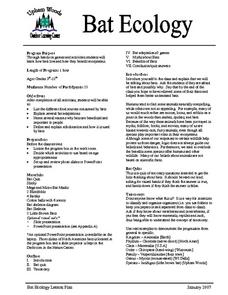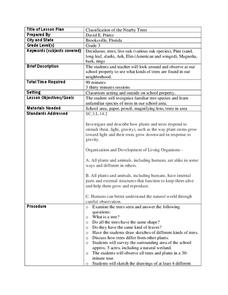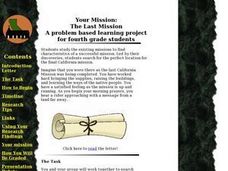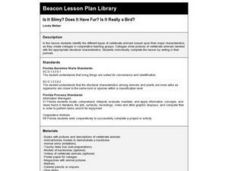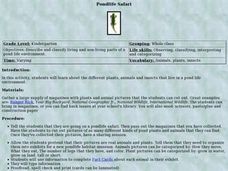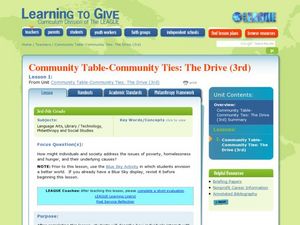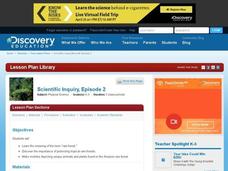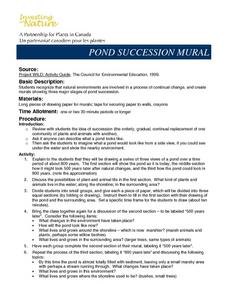Curated OER
Unique Ecosystems
Fourth graders explain how in any particular environment, some kinds of
plants and animals survive well, some survive less well, and some cannot survive at all. They research the ecosystem of which each animal or plant is natively a part.
Curated OER
Bat Ecology
Young scholars, through hands on games and activities, discover how bats live and how bats benefit ecosystems. They play a game designed to show them how echolocation works and another to show how mother bats locate their young through...
Curated OER
Measuring Biodiversity
Students explore a few key concepts associated with measuring biodiversity. They are told that biodiversity can be measured in a number of ways. Genetic diversity is a measure of the genes represented in the sample. Ecosystem...
Curated OER
Charlotte's Web
Fourth graders focus on fluency by reading the book Charlotte's Web. In this reading strategies lesson plan, 4th graders partner read, do guided reading, and independent reading to increase fluency. Students use Venn Diagrams, discuss...
Curated OER
Beach Life: Spanish Banks Field Trip
Students discover beach life. In this beach life lesson, students visit a beach to find plant and animal species that live there. They discuss the life cycle and needs of some of these animals through a variety of activities.
Curated OER
Classification of the Nearby Trees
Third graders practice using classification techniques to identify local trees. In this plant life instructional activity, 3rd graders discuss how trees differ from other plants and what characteristics are unique to trees alone....
Curated OER
Who Eats Who?
Students recognize that some animals eat plants, some eat meat and some both. For this who eats who lesson, students chart animals in a food chain. Students research information from reading articles. Students chart what animals eat...
Curated OER
Your Mission: The Last Mission
Fourth graders develop a research report to determine the best location for the final California mission. They conduct Internet research, create charts and diagrams, and develop a presentation.
Curated OER
An Emerald Place
Students discover four layers of the rain forest and identify the life of animals at each level.
Curated OER
Is It Slimy? Does It Have Fur? Is It Really a Bird?
Sixth graders identify the different types of vertebrate animals based upon their major characteristics, as they create collages in groups. Collages show pictures of vertebrate animals labeled with the appropriate structural...
Curated OER
Creative Writing Lesson Plan: Combination Creature
Students navigate through an online interactive virtual zoo to create imaginary animals by combining different parts of real animals. They write a short story about their combination creature.
Curated OER
Jack London's The Call of the Wild: "Nature Faker"?
Middle schoolers take a stand on whether or not London could be dubbed a "nature faker." They support their position with evidence either historical or from the text. Students write an essay, complete with hypothesis and textual support,...
Curated OER
Pond-life Safari
Students determine the living and non-living parts of pond life. In this pond life lesson, students examine the plants, animals, and insects that live in ponds. They look through a variety of print media, cut out pictures, and arrange...
Curated OER
The Farmer and the Cowman
What is the difference between a ranch and a farm? After reading and discussing the provided background information, young agriculturalists will color, cut, and create neat little booklets that show the differences between ranches and...
Curated OER
Activity Plan 5-6: S.O.S. - Save Our Species!
Young scholars create a banner or flag about an endangered animal to teach others about their plight for survival. In this environmental science lesson plan, the class will work to create a list of endangered animals, then create a...
Curated OER
Community Table-Community Ties: The Drive
Students explore the concept of philanthropy. In this service learning lesson, students consider the issues of hunger and homelessness. Students explore literature dealing with the topics and brainstorm ways they may be able to help others.
Curated OER
The Unique Rain Forest
Students explore the unique Rain Forest. In this Rain Forest lesson, students watch a video about the dangers the Rain Forest faces. Students create a Rain Forest mobile. Students choose plants or animals from the Rain Forest then write...
Curated OER
Moving and Growing
Students explore the types of skeletons in various animals. In this skeletal systems lesson, students watch a video clip about skeletons, view a human skeleton, compare the skeletons of humans, chickens and fish, and learn about...
Curated OER
Gone But Not Forgotten
Third graders examine animals and organisms that have become extinct and their similarities to living organisms. In this extinction lesson plan students divide into groups and research extinct animals.
Curated OER
Garden of Eden
Students view a video clip about animals and their habitats. They work together to discuss how different animals adapt to their environments. They create a new habitat for a specific animal and draw new adaptations for them.
Curated OER
How Big is a Dinosaur?
Fourth graders create enlarged replica of a stegosaurus drawing, using a grid to practice coordinates.
Curated OER
Clifford Learns About the Circus and So Do We!
Students investigate the characteristics of different circus jobs and the animals commonly seen at the circus. They read a book about clowns and construct and perform a trick hot dog. Students also create a clown accordion book.
Curated OER
Pond Succession Mural
Students recognize that natural environments are involved in a process of continual change, and create murals showing three major stages of pond succession. They review the idea of succession (the orderly, gradual, continual replacement...
Curated OER
Food Web Mobile
Students explain the main concepts of food webs and food chains. They
describe the role of animals, plants, and other organisms in cycling energy and matter through a food web by creating mobiles. Lesson contains adaptations for all levels.



